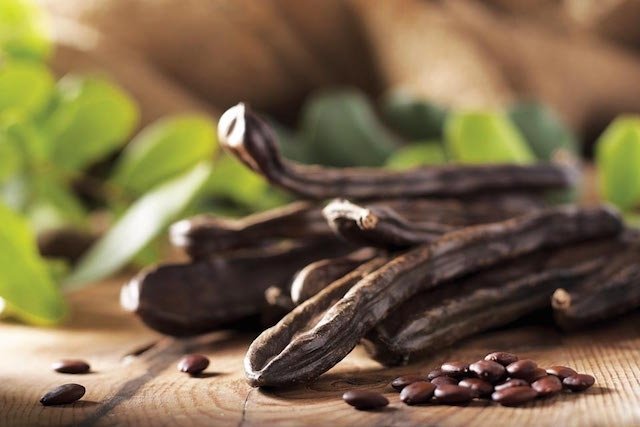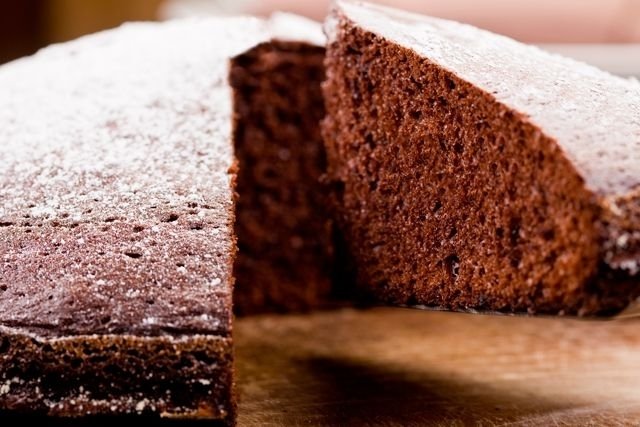Carob is the fruit that grows on a carob tree or shrub. It produces dark pods that contain 8 to 12 brown seeds that are associated with a sweet flavor.
This fruit is rich in antioxidants, mainly polyphenols, and can be used as an alternative to cocoa powder or chocolate, as it has a similar flavor. Furthermore, carob is low in calories and is an excellent source of fiber, B vitamins, calcium and magnesium.
You can find carob powder, gum or cream in grocery stores, health food stores or online. It can be mixed with milk or added to recipes traditionally made with chocolate, such as cookies and cakes. There are also processed carob products available for purchased, as cereal bars and jellies.

Health benefits
The main health benefits of carob are:
1. Improving gastrointestinal health
Because it contains fiber and tannins, carob helps to improve gastrointestinal health. It can reduce diarrhea, heartburn and vomiting, while also maintaining healthy gut bacteria,
2. Managing cholesterol
Carob is rich in antioxidants, which help to manage LDL cholesterol and triglyceride levels. Therefore it can play a role in preventing cardiovascular diseases, such as atherosclerosis, as antioxidants prevent fat deposit in the arteries and decreased fat absorption in the body.
3. Regulating blood sugar levels
Because it is rich in fiber, such as pectin, carob can help to control diabetes by keeping blood glucose levels within normal ranges. Foods that are enriched with carob typically have a lower glycemic index, which are great to include in a diabetic diet.
4. Promoting bone health
Carob is rich in calcium and magnesium, minerals that improve bone density and, consequently, strengthen the bones and teeth. It can be useful for preventing fractures and osteoporosis.
5. Promoting weight loss
Carob is low in calories, rich in fiber and has a low fat content. Therefore, when this fruit is part of a healthy and balanced diet, it can increase how full you feel and promote weight loss.
6. Possibly improving sleep quality
As it does not contain caffeine and has a sweet flavor, carob can be used as a substitute for chocolate or cocoa. It can be consumed at night without interfering with sleep quality, particularly in people who are sensitive to caffeine.
7. Possibly preventing cancer
Because it is rich in antioxidants, carob could protect cells from damage caused by free radicals, in addition to exerting anti-inflammatory action, which could help prevent cancer. However, more studies are needed so that this effect of carob can be confirmed.
Nutritional information
The following table outlines the nutritional information for 100 grams of carob powder, also known as carob flour:
To obtain the benefits that carob has to offer, this fruit must be included in a healthy and balanced diet with regular exercise.
How to consume
Carob can be used in powder form in recipes for cakes, puddings, cookies and sweets. It can be swapped as a substitute for cocoa powder or chocolate.
Furthermore, carrob gum serves as a thickener, emulsifier and gelling agent in various processed products. The gum can also be used in some infant formulas as a thickener with the aim of reducing reflux and vomiting.
Carob milk
Carob milk is a drink that can be used to replace chocolate milk, as its flavor is very similar and it does not contain caffeine. To prepare, simply add 1 teaspoon of carob flour to 1 glass of milk, which can be sweetened if desired.
Carob gum for vomiting or reflux
Mix 1 tablespoon of carob gum with 1 glass of water and then drink. For babies, the measurement should be 1.2 to 2.4 g of gum for 120 ml of milk.
Carob flour for diarrhea
Mix 25 g of flour in 1 glass of water or warm milk. Drink after each episode of diarrhea. This recipe with carob flour when combined with sunflower seed and rice flour can also be used to treat diarrhea for babies and pregnant women.
Healthy carob recipes

Below are some healthy recipes that use carob flour:
1. Gluten-free carob cake
This recipe is easy to make and does not contain gluten, making it a good option for those with gluten intolerance or celiac disease.
Ingredients:
- 350 g of brown sugar
- 5 eggs
- 150 ml of soybean oil
- 200 g of natural yogurt
- 30 g of carob powder
- 200 g of rice cream
- 150 g of sweet cassava starch
- 150 g of potato starch
- 10 drops of vanilla essence
- 10 g of baking powder
Directions
Beat the eggs, oil, sugar, natural yogurt and vanilla essence in a blender. Then add the dry ingredients, mixing well until it forms a uniform dough. Finally add the yeast and stir gently to mix well. Bake in a greased and floured pan for 25 minutes, at 210ºC (or 410ºF).
2. Carob cream
Ingredients
- 200 ml of cold milk
- 2 spoons of cornstarch
- 2 spoons of carob powder
- 1 spoon of sugar
- 1 cinnamon stick
Directions
Mix the cornstarch with the cold milk and once dissolved, add the other ingredients and cook over low heat for a few minutes, until it thickens. Once thickened, remove from heat, remove the cinnamon stick, pour into serving cups and refrigerate for 1 hour. Serve cold.
3. Carob and quinoa pancakes
Ingredients
- 1 tablespoon of carob flour
- 1 cup of quinoa, oat or almond flour
- 1 egg white
- 1 cup of rice milk or any other plant-based milk
- 1 teaspoon of stevia
- 1 pinch of salt
- 1 pinch of baking soda
Directions
Beat the egg white and then add the milk, stevia, salt and mix well. Then add the dry ingredients and mix until well-combined. Heat a frying pan over medium heat and grease with a little olive oil.
Then, place a ladle of the mixture in the frying pan and let each side cook for 5 minutes or until bubbles form on its surface. Serve with cheese, honey or jam.
